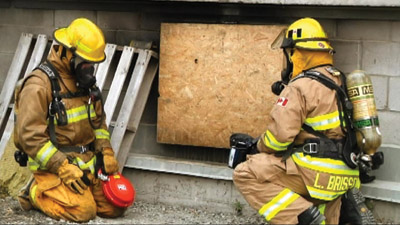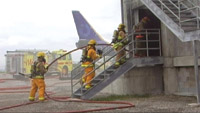
Equipment
New products
Suppression assessment
Basement fires present a significant risk to firefighters attempting interior attack. In a recent Canadian Police Research Centre (CPRC)-funded project, the use of aerosol suppression technology was evaluated to determine if these risks could be reduced.
March 1, 2011
By Sean Tracey
Basement fires present a significant risk to firefighters attempting interior attack. In a recent Canadian Police Research Centre (CPRC)-funded project, the use of aerosol suppression technology was evaluated to determine if these risks could be reduced. The project was ideal for CPRC as its mandate was to harness science and technology knowledge to strengthen police, fire and emergency medical services across Canada through research, development of standards, product evaluation, technology transfer, science and technology advocacy, and by providing expertise in this field. Additionally, the use of aerosol suppression technology in basement fires has not been sufficiently documented under controlled conditions, even though it has been effectively deployed in numerous fire saves across North America.
 |
| Firefighters prepare to use aerosol suppression technology during testing at the Fire and Emergency Services Training Institute at Pearson International Airport in Toronto. The experiment showed that aerosol suppression technology may reduce the risk to firefighters entering a basement fire. Photo by Sean Tracey |
In this project, completed in October, researchers evaluated the impact of using an aerosol fire suppressant agent on fire growth, and the actions of the firefighting team, in four scenarios involving simulated basement fires.
When responding to basement fires, personnel are often required to enter dwellings from the floor above the fire and then proceed down a stairwell while being exposed to the superheated gases. Personnel must attempt entry into the basement area as soon as possible to prevent the rapid growth and spread of the fire. The longer the delay, the greater the potential damage to floor systems. Alternatively, crews could use ventilation, but this introduces the risk of providing oxygen (thus feeding the fire growth). It was therefore proposed that aerosol suppressant agents could be deployed while the attack team is preparing for entry. Anecdotal reports and manufacturers’ data show that aerosol devices can rapidly knock down Class A and Class B fires. This may have the effect of stopping further fire spread and reducing temperatures; therefore, the aerosol devices will have the same or better effectiveness than ventilation. Use of the devices may reduce property damage and reduce the risk of personal injury to the firefighters. What has not been reported is the potential impact that employing the technology may have on firefighting operations.
The objective of the CPRC project was to measure the effectiveness of an aerosol suppressant agent in a basement fire scenario and then to evaluate the impact that use of the agent may have on suppression operations. A review of fire-service literature found many fire fatality related reports that outlined the need to improve safety; however, no reports were found on the use of aerosol technology in this high-risk environment. This research project was intended to produce data for further evaluation of the effectiveness of aerosol suppression technology in extinguishing basement fires and to produce an optimal deployment procedure for the technology.
Aerosol devices work through a chemical reaction. A portable device generates a large quantity of salts and oxides of alkali and alkaline metals in an aerosol form. The aerosol is discharged from a canister as a hot white smoke, which will then disperse throughout the fire compartment. The particles generated are approximately one micron in size, and because of this small size, the particles will remain airborne in the compartment for up to 50 minutes. The small size of the particles allows them to be drawn on thermal currents into the seat of the fire, where they bond with free radicals and interrupt the chain reaction that sustains the fire. The heat in the room provides the needed energy to fuel this chemical reaction. This should result in a significant drop in the fire compartment temperature. Because these small particles can remain airborne for up to 50 minutes, there is a significant reduction in any potential for the fire to reignite. The aerosol product has been assessed by manufacturers and has been determined not to be hazardous to humans; however, the product is an irritant and therefore should it be avoided. In this project, the evaluations were conducted by ARA Safety and the device used was its ARA Fit Pro™.
 |
|
| One area of concern was the potential impact of the aerosol product on the bunker gear, SCBA and other components, but no negative impact or comments on the PPE were reported. Photo by Sean Tracey |
The Fire and Emergency Services Training Institute (FESTI) at Toronto’s Pearson Airport was chosen as the site for the evaluation. Its world-class facilities include a recently updated live-fire training structure. This structure provided accessible basement areas, meaning evaluations could be replicated without significant modifications. Additionally, the setup at FESTI meant that the safety protocols identified in NFPA 1403: Standard on Live Fire Training Evolutions for safety on the fire ground could be closely followed. The structure is non-combustible, so there was no risk of collapse. FESTI had participated in past evaluations: its officers were extremely accommodating and ensured that the project was completed successfully. FESTI staff acted as the interior attack team.
Unbiased reporting and a peer review process were important requirements of the CPRC for the project. To conduct the peer review, Barry Colledge, a professional engineer with fire-service experience, was called in from Morrison Herschfield’s Calgary office and Richmond Hill Fire Chief Steve Kraft represented the Ontario Association of Fire Chiefs. In addition to overseeing the evaluation, Colledge and Kraft reviewed the study report and the resulting protocol that was developed.
Four separate evaluations were performed. A standard fire intended to reflect the fuel loading in a typical Canadian, single-family dwelling was used in each case. The scenario included a three-seat sofa with polyurethane cushions, two wooden pallets and straw. The evaluations included:
- Evaluation 1 – no aerosol suppressant.
- Evaluation 2 – the deployment of the aerosol device into the fire compartment.
- Evaluation 3 – the deployment of the aerosol device into a compartment remote from the fire.
- Evaluation 4 – the deployment of the aerosol device into a compartment remote from the fire, windows opened, and the use of positive pressure ventilation at the entry door.
The aerosol product was used in a basement with a greater volume than the rated capacity of the product for extinguishment of Class A fires. Regardless, when the aerosol was used, it had a marked impact on the temperature in the fire compartment. Within one minute, the temperature in the fire compartment dropped from a high of 552 C to approximately 165 C. But this came at a cost. Visibility was significantly reduced throughout the fire floor. Even though the responding personnel were intimately familiar with the training structure, they had difficulty negotiating the structure and stairs and finding the fire. Personnel reported not being able to see their hands or feet, and, in some cases, the fire itself. This was evidenced in the extra time it took the entry personnel to find and extinguish the fire. A thermal imaging camera was essential for entry personnel. One area of concern was the potential impact of the aerosol product on the bunker gear, SCBA and other components, but no negative impact or comments on the protective ensemble were reported.
One of the project’s deliverables was the production of a deployment protocol. In compiling this document, several National Institute for Occupational Safety and Health firefighter fatality reports for basement fires were reviewed and the applicable NIOSH recommendations were included. Some of the recommendations to reduce risks to personnel when aerosol devices are deployed are:
- Only personnel who have undertaken the manufacturer’s required training should be authorized to deploy these devices.
- The incident commander (IC), after a thorough size-up of the fire, should determine if the device should be deployed.
- The IC should authorize entry into the structure only after the device has been activated for at least one minute.
- Entry personnel including rapid intervention team personnel should have a thermal imaging camera.
- Entry personnel should be equipped with radios and regularly report fire conditions back to the IC.
The use of aerosol suppression technology may, in certain cases, reduce the risk to firefighters entering a basement fire. Under certain conditions, the IC may make a decision to deploy one or more of these devices prior to interior attack. A protocol has been developed for use of aerosol suppressant agents that may help reduce the risk to firefighters. However, the technology has some limitations, such as the significantly decreased visibility that can limit the effectiveness of first responders when entering the structure.
Print this page